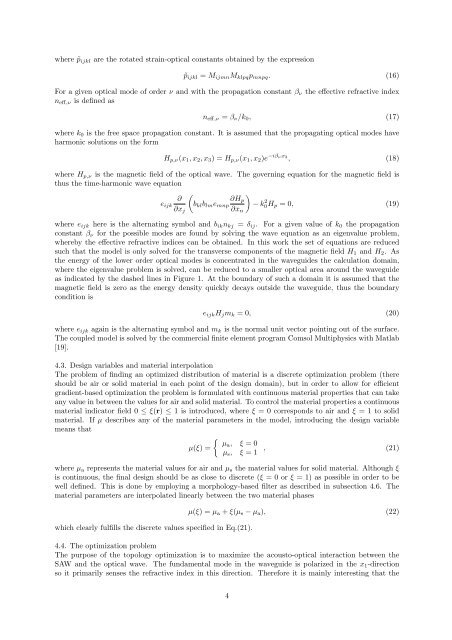Maria Bayard Dühring - Solid Mechanics
Maria Bayard Dühring - Solid Mechanics
Maria Bayard Dühring - Solid Mechanics
Create successful ePaper yourself
Turn your PDF publications into a flip-book with our unique Google optimized e-Paper software.
where ˜pijkl are the rotated strain-optical constants obtained by the expression<br />
˜pijkl = MijmnMklpqpmnpq. (16)<br />
For a given optical mode of order ν and with the propagation constant βν the effective refractive index<br />
neff,ν is defined as<br />
neff,ν = βν/k0, (17)<br />
where k0 is the free space propagation constant. It is assumed that the propagating optical modes have<br />
harmonic solutions on the form<br />
Hp,ν(x1, x2, x3) = Hp,ν(x1, x2)e −iβνx3 , (18)<br />
where Hp,ν is the magnetic field of the optical wave. The governing equation for the magnetic field is<br />
thus the time-harmonic wave equation<br />
<br />
<br />
∂<br />
∂Hp<br />
eijk bklblmemnp − k<br />
∂xj<br />
∂xn<br />
2 0Hp = 0, (19)<br />
where eijk here is the alternating symbol and biknkj = δij. For a given value of k0 the propagation<br />
constant βν for the possible modes are found by solving the wave equation as an eigenvalue problem,<br />
whereby the effective refractive indices can be obtained. In this work the set of equations are reduced<br />
such that the model is only solved for the transverse components of the magnetic field H1 and H2. As<br />
the energy of the lower order optical modes is concentrated in the waveguides the calculation domain,<br />
where the eigenvalue problem is solved, can be reduced to a smaller optical area around the waveguide<br />
as indicated by the dashed lines in Figure 1. At the boundary of such a domain it is assumed that the<br />
magnetic field is zero as the energy density quickly decays outside the waveguide, thus the boundary<br />
condition is<br />
eijkHjmk = 0, (20)<br />
where eijk again is the alternating symbol and mk is the normal unit vector pointing out of the surface.<br />
The coupled model is solved by the commercial finite element program Comsol Multiphysics with Matlab<br />
[19].<br />
4.3. Design variables and material interpolation<br />
The problem of finding an optimized distribution of material is a discrete optimization problem (there<br />
should be air or solid material in each point of the design domain), but in order to allow for efficient<br />
gradient-based optimization the problem is formulated with continuous material properties that can take<br />
any value in between the values for air and solid material. To control the material properties a continuous<br />
material indicator field 0 ≤ ξ(r) ≤ 1 is introduced, where ξ = 0 corresponds to air and ξ = 1 to solid<br />
material. If µ describes any of the material parameters in the model, introducing the design variable<br />
means that<br />
µ(ξ) =<br />
µa, ξ = 0<br />
µs, ξ = 1<br />
, (21)<br />
where µa represents the material values for air and µs the material values for solid material. Although ξ<br />
is continuous, the final design should be as close to discrete (ξ = 0 or ξ = 1) as possible in order to be<br />
well defined. This is done by employing a morphology-based filter as described in subsection 4.6. The<br />
material parameters are interpolated linearly between the two material phases<br />
which clearly fulfills the discrete values specified in Eq.(21).<br />
µ(ξ) = µa + ξ(µs − µa), (22)<br />
4.4. The optimization problem<br />
The purpose of the topology optimization is to maximize the acousto-optical interaction between the<br />
SAW and the optical wave. The fundamental mode in the waveguide is polarized in the x1-direction<br />
so it primarily senses the refractive index in this direction. Therefore it is mainly interesting that the<br />
4
















